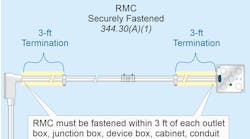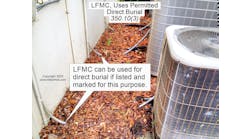Q. I'm confused. Can you please explain the 25-ft feeder tap rule and provide an example?
A. Feeder tap conductors up to 25 ft long are permitted without overcurrent protection at the tap location if the tap conductors comply with the following [240.21(B)(2)]:
- The ampacity of the tap conductors must not be less than one-third the rating of the overcurrent device that protects the feeder.
- The tap conductors terminate in a single circuit breaker, or set of fuses rated no more than the tap conductor ampacity in accordance with 310.15 [Table 310.15(B)(16)].
- The tap conductors are protected from physical damage by being enclosed in a manner approved by the authority having jurisdiction (AHJ), such as within a raceway.
A 400A breaker protects a set of 500kcmil feeder conductors. There are three taps fed from the 500kcmil feeders that supply disconnects with 200A, 150A, and 100A overcurrent devices.
- 200A: 3/0 AWG is rated 200A at 75°C, and is greater than one-third of the rating of the 400A overcurrent device [Table 310.15(B)(16)].
- 150A: 1/0 AWG has an ampacity of 150A at 75°C, and is greater than one-third of the rating of the 400A overcurrent device [Table 310.15(B)(16)].
- 100A: 1/0 AWG has an ampacity of 150A at 75°C, and is greater than one-third of the rating of the 400A overcurrent device [Table 310.15(B)(16)]. Anything smaller than 1/0 AWG can't be used, as it will have an ampacity of less than one-third of 400A in the 75°C column.



